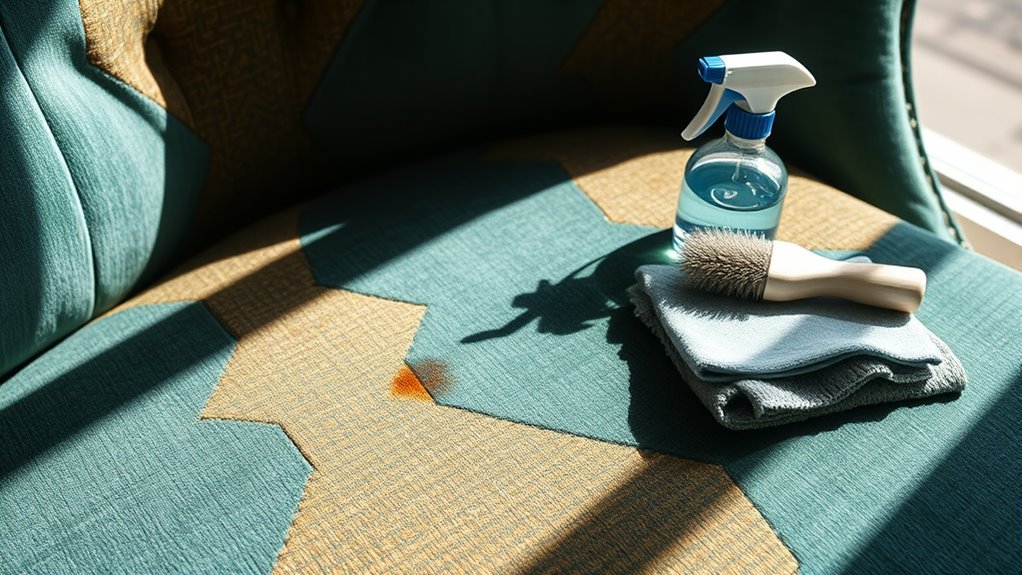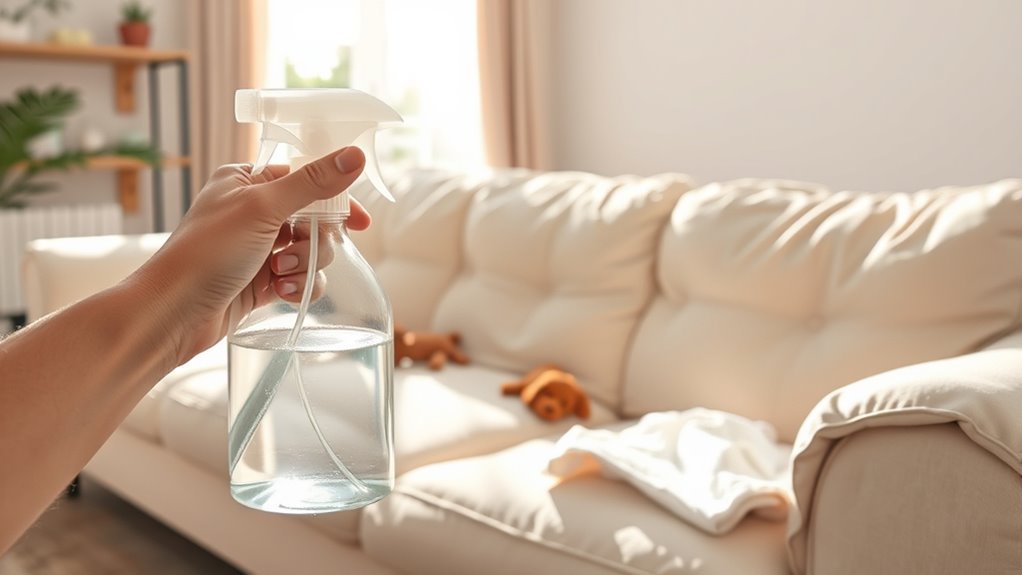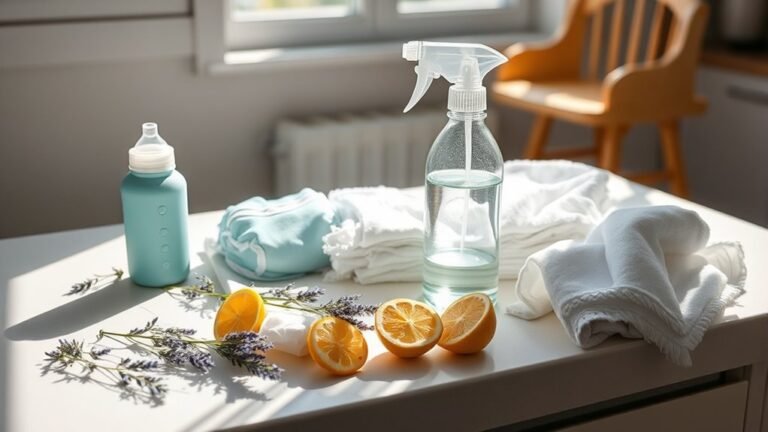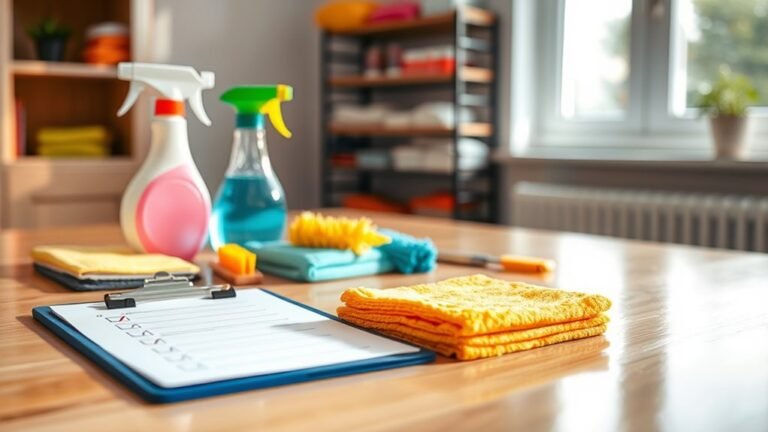How to Remove Stains From Upholstered Furniture
To remove stains from your upholstered furniture, first identify the fabric type to choose the right cleaning method. Act fast by blotting spills gently without rubbing. Use mild solutions like soapy water or a vinegar mix, and test on a hidden spot to avoid damage. Treat pet, food, or grease stains appropriately with specific techniques like baking soda or pet odor removers. If stains persist or fabric is delicate, professional help might be best. Keep exploring to get more detailed tips.
Identifying the Type of Upholstery Fabric

How do you know what kind of fabric your upholstered furniture is made from? Start by examining the fabric characteristics closely. Feel the texture—smooth, coarse, or plush—and note the weave pattern. Natural fibers like cotton or linen often feel breathable and soft, while synthetics like polyester or nylon tend to be more resilient and water-resistant. Understanding upholstery types helps you choose the right stain removal approach without risking damage. Check for tags or manufacturer labels; they usually specify the fabric content. If labels are missing, consider testing a hidden spot with water or mild detergent to observe how the fabric reacts. Recognizing these fabric traits gives you the freedom to tackle stains confidently, preserving your furniture’s appearance and longevity.
General Tips for Stain Removal
Removing stains from upholstered furniture requires quick action and the right techniques to prevent permanent damage. When you spot a stain, don’t wait—blot it gently with a clean cloth to absorb as much as possible without rubbing, which can spread the stain. Always test any cleaning solution on a hidden area first to avoid discoloration. Regular upholstery maintenance, like vacuuming and rotating cushions, helps keep fabrics fresh and reduces the chance of stubborn stains setting in. For stain prevention, consider treating your furniture with a fabric protector to create a barrier against spills. Remember, consistent care and prompt attention give you the freedom to enjoy your furniture without worry, making stain removal manageable and your upholstery looking its best.
Removing Food and Beverage Stains

When you spill food or drinks on your upholstery, acting quickly is key to preventing stains from setting. Using the right cleaning solutions will help lift the stain without damaging your fabric. Always treat your furniture gently to keep it looking its best while removing those stubborn spots.
Immediate Stain Treatment
The first few minutes after a spill are crucial for preventing permanent stains on your upholstered furniture. You’ve got to act fast—immediate response and quick action are your best friends here. Grab a clean cloth or paper towel and gently blot the spill; don’t rub, as that can push the stain deeper. If the stain is wet, absorb as much liquid as possible without spreading it. Keep your movements light and deliberate to avoid damaging the fabric. Remember, the goal is to stop the stain from setting in before it’s too late. By treating spills right away, you maintain your freedom from stubborn stains, keeping your furniture looking fresh and inviting without complicated steps or harsh chemicals.
Effective Cleaning Solutions
Although it might seem tricky at first, tackling food and beverage stains on upholstery becomes manageable once you know which cleaning solutions work best. Using the right products not only removes stains but also supports your stain prevention tips and upholstery maintenance techniques. Here’s a quick guide:
- Mild Dish Soap Solution: Mix a few drops of dish soap with warm water. Dab gently to lift stains without soaking fabric.
- White Vinegar Mix: Combine equal parts vinegar and water. It neutralizes odors and breaks down tough stains.
- Baking Soda Paste: Apply a paste for greasy or sticky spots, then vacuum once dry.
- Commercial Upholstery Cleaner: Choose one suited for your fabric type, following label instructions carefully.
These options give you freedom to keep your furniture fresh and stain-free.
Gentle Fabric Care
Since food and beverage stains can set quickly, you’ll want to act fast but gently to avoid damaging your upholstery. Start by blotting the stain with a clean, white cloth to absorb excess liquid—never rub, as that can push the stain deeper. Use a solution made for gentle cleaning, like a mix of mild dish soap and water, and test it first on a hidden spot. Apply sparingly, blotting rather than soaking the fabric to maintain its integrity. After treating the stain, rinse with a damp cloth to remove any residue. To keep your upholstered furniture looking its best, consider fabric protection sprays that guard against future spills while allowing you the freedom to enjoy your space without worry.
Tackling Pet-Related Stains and Odors

When your furry friends leave stains or odors on your upholstery, you’ll want to act quickly to prevent lasting damage. Tackling pet-related stains and odors is all about swift, effective care. Here’s how to keep your furniture fresh and clean:
- Blot the stain gently with a clean cloth to avoid spreading it.
- Use pet odor elimination products designed specifically for upholstery.
- Apply stain prevention techniques, like treating fabric with a protective spray.
- Regularly wash pet bedding and vacuum furniture to reduce hair and dander.
Dealing With Ink and Dye Stains
If you spot ink or dye stains on your upholstery, acting fast is key to preventing permanent marks. Start by blotting the stain gently with a clean cloth to avoid spreading it. Use ink removal techniques like applying rubbing alcohol or a specialized stain remover, dabbing carefully without rubbing. Always test any solution on a hidden area first to protect your fabric. For dye transfer prevention, avoid mixing colors and clean spills immediately to stop the dye from setting. You can also use cold water to dilute the stain before treating it. Staying calm and tackling the stain right away gives you the freedom to keep your furniture looking fresh without harsh scrubbing or damage. Quick action is your best defense against stubborn ink and dye stains.
Cleaning Oil and Grease Spots
Although oil and grease stains can seem stubborn, you don’t have to worry—they can be treated effectively with the right approach. Start by using oil absorption methods to soak up excess grease without spreading it.
- Sprinkle baking soda, cornstarch, or talcum powder on the spot and let it sit for 15-20 minutes to absorb oil.
- Gently vacuum or brush away the powder without rubbing the stain deeper.
- Apply a grease lifting agent designed for upholstery, following the product instructions carefully.
- Blot the area with a clean cloth, working from the outside in, to lift remaining grease.
Using Homemade Cleaning Solutions Safely
When using homemade cleaning solutions, you’ll want to combine ingredients that are safe for your upholstery to avoid damage. Always test a small, hidden area first to see how the fabric reacts. This simple step helps prevent unexpected stains or discoloration.
Safe Ingredient Combinations
Two common homemade cleaning ingredients you’ll want to combine carefully are vinegar and baking soda. While both are fantastic natural alternatives, mixing them directly creates a fizzy reaction that can reduce cleaning power. To enjoy safe combinations, keep these tips in mind:
- Use baking soda as a gentle abrasive, then spray vinegar separately to lift stains.
- Avoid mixing bleach with vinegar or ammonia—this creates harmful fumes.
- Lemon juice pairs well with baking soda for fresh, effective stain removal.
- Always dilute essential oils before adding to solutions to prevent fabric damage.
Testing Solutions First
Mixing ingredients safely is just one part of protecting your upholstery during cleaning. Before you plunge into any homemade solution, you’ve got to test it first. Use simple testing methods by applying a small amount of your cleaner to an inconspicuous spot on the fabric. This way, you can check for fabric compatibility without ruining the entire piece. Look for any discoloration, texture changes, or weakening of fibers. If the test spot holds up, you’re good to go. If not, adjust your formula or try a different approach. Taking this quick step gives you freedom to clean confidently, knowing you’re preserving your furniture’s original look and feel without unexpected damage. Testing first keeps your upholstery safe and your cleaning effective.
When to Call a Professional Upholstery Cleaner
Though many stains can be tackled with DIY methods, there are times when calling a professional upholstery cleaner is your best bet. Knowing when to seek expert help can save your furniture and give you peace of mind.
Consider professional cleaning if:
- Stains are old or deeply set, resisting home treatments.
- Your fabric is delicate or requires special care you’re unsure about.
- You want to maintain your upholstery’s life and appearance with expert upholstery maintenance.
- DIY attempts have spread or worsened the stain.
Frequently Asked Questions
Can Upholstery Stain Removers Damage the Color or Texture?
Yes, upholstery stain removers can sometimes cause color fading or texture alteration if they’re too harsh or not suited for your fabric. You’ll want to test any product on a hidden spot first to avoid surprises. Don’t let fear hold you back—just be cautious and follow instructions. That way, you keep your furniture vibrant and comfy while enjoying the freedom to tackle stains confidently without damaging your favorite pieces.
How Often Should I Deep Clean Upholstered Furniture?
You should aim for a deep clean of your upholstered furniture every 12 to 18 months. This cleaning frequency helps keep your furniture fresh and extends its life. For maintenance tips, regularly vacuum and spot-clean spills immediately to prevent buildup. Remember, staying on top of these small tasks gives you freedom from stubborn stains and costly repairs later on. Keep it simple, and your furniture will thank you!
Are Steam Cleaners Safe for All Upholstery Types?
Steam cleaner types vary, and not all are safe for every fabric. You’ll want to check fabric compatibility before using one on your upholstery. Delicate fabrics like silk or velvet might get damaged by steam, while synthetic fibers usually handle it well. Always test a small hidden spot first to avoid surprises. Choosing the right steam cleaner lets you refresh your furniture without risking damage, giving you freedom to clean confidently.
What Is the Best Way to Prevent Future Stains?
To prevent future stains, you should invest in fabric protection sprays that create a barrier against spills. These treatments let you enjoy your space without constant worry. Pair that with regular maintenance—like vacuuming and prompt spot cleaning—to keep your furniture looking fresh and vibrant. By staying proactive, you’ll have the freedom to relax and entertain without stressing over every little mess or accident. It’s all about easy care and peace of mind.
Can Upholstery Stains Affect Indoor Air Quality?
Think of stain sources like tiny invaders sneaking into your space. Yes, those stains on your upholstery can release air pollutants, affecting indoor air quality. They often harbor dust mites, mold, or bacteria, which mix with the air you breathe, limiting your freedom to enjoy a fresh, clean home. By tackling stains quickly, you’re not just preserving your furniture—you’re protecting the pure air that lets you live freely and comfortably.






